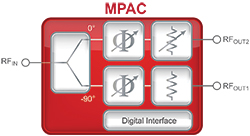
Anyone who’s been tasked with implementing a Doherty power amplifier (PA) for a wireless base station transmitter can attest to the difficulties that lie in Doherty amplifier optimization. There are the manufacturing variances, the manual tweaking of each module, the discrete components and their own variances, not to mention the lack of flexibility after optimization. Any mismatch or misalignment in phase and amplitude between the Doherty architecture’s carrier and peaking paths can quickly contribute to higher costs and degradation of the overall performance. If the carrier and peaking amplifiers are not in sync, the final output will not reach the output performance as designed.
Today, most macrocell RF engineers manage this complexity using discrete components to tune the phase and amplitude for each one of the carrier and peaking paths. Unfortunately, these discrete components require substantial engineering time and expertise, because optimization is both manual and laborious. Engineers must determine the discrete component values and how to put them on the board. Once the discrete components are on the board, there is no flexibility to make changes for unexpected power transistor variances. The RF engineer is also left with no way to optimize the phase and amplitude. Doherty PA optimization is a time-consuming challenge — time that is also an investment cost for the company.
Despite these challenges, the Doherty amplifier continues to dominate the wireless infrastructure equipment market. Why? The answer is the amplifier’s ability to accommodate high peak-to-average ratios (PAR). With the advent of quadrature amplitude modulation in wireless and the worldwide rollout of LTE and LTE-A, the PAR required is around 9 dB. A Doherty configuration uses load modulation to achieve very high efficiencies under back-off conditions. The back-off efficiencies are key to keeping the overall system efficiency of the PA module high for LTE signals. Most wireless base stations — macro, micro and picocells — implement a Doherty architecture to improve PA efficiencies, especially when quadrature amplitude modulation is used.
Aware of the challenges in Doherty PA optimization, Peregrine Semiconductor developed a solution, announced at the International Microwave Symposium (IMS) in May 2015. Peregrine’s PE46120 was the first product in the UltraCMOS® MPAC (monolithic phase and amplitude controller) family. Peregrine is now adding two new controllers: the PE46130 and PE46140. The three MPAC products in the family enable alignment of the phase and amplitude between the Doherty amplifier’s carrier and peaking paths through a digital interface. Each monolithic controller integrates a 90-degree phase splitter, 5-bit digital phase shifter, 4-bit digital step attenuator and a digital serial peripheral (SPI) interface (see block diagram).
ADVANTAGES
The PE46120, PE46130 and PE46140 eliminate the need for multiple discrete components and can be used to optimize Doherty power amplifiers using either laterally diffused metal oxide semiconductor (LDMOS) or gallium nitride (GaN) devices. When used for Doherty amplifier optimization, the monolithic controllers offer the following benefits to wireless infrastructure vendors:
- Better performance. Power-added efficiency, linearity across frequency and Doherty bandwidth improve through better matching and increased effectiveness of the digital predistortion (DPD) loop. If a company is not already investing in module-by-module tuning, engineers can expect to see a three to four percent efficiency increase — a huge improvement.
- Reduced bill of materials (BOM) cost by improving the overall yield of expensive Doherty power amplifier assemblies.
- Improved system reliability and increased transceiver yield from better uniformity and repeatability of transceiver paths.
- Maximum tuning flexibility to adjust the phase and amplitude in real-time for operational and environmental factors.

Figure 1 The PE46120, PE46130 and PE46140 cover various cellular bands.
As the controllers are built on an UltraCMOS silicon on sapphire (SOS) monolithic die, RF engineers can trust the uniformity and manufacturing reliability of the process. Only UltraCMOS technology enables intelligent integration, a unique design capability that enables the integration of RF, digital and analog components onto a single die. Peregrine uses this design capability to offer benefits such as configurability, flexibility, enhanced performance, ease-of-use and a reduced form factor.
PERFORMANCE
Designed for the LTE and LTE-Awireless infrastructure transceiver market, the three monolithic controllers cover several cellular frequency bands (see Figure 1). The PE46120 provides excellent phase and amplitude accuracy from 1.8 to 2.2 GHz, the PE46130 covers 2.3 to 2.7 GHz and the PE46140 covers 3.4 to 3.8 GHz. Although they cover different frequency ranges, the PE46120, PE46130 and PE46140 are similar in features and performance advantages. The controllers provide a phase range of 87.2 degrees in 2.8 degree steps and an attenuation range of 7.5 dB in 0.5 dB steps. They deliver high linearity, 60 dBm IIP3, and handle 35 dBm input power with only at 0.1 dB compression. Port-to-port isolation is 30 dB, and current consumption is only 0.35 mA. UltraCMOS technology enables the controllers to withstand ESD of at least 1 kV on all RF pins and operate over an extended temperature range to +105°C and a power supply range from 2.3 to 5.5 V. Each controller is offered in a RoHS compliant, 32-lead, 6 × 6 mm QFN.
Compared to GaAs-based module solutions, the PE46120, PE46130 and PE46140 offer:
- > 20 dB better linearity (IIP3)
- 2.5× the resolution at twice the range of phase control
- >10 dB increased port-to-port isolation
- 4 dB more RF input power (CW)
- Wider power-supply operation.
In addition to Doherty amplifiers, the MPAC family can optimize the performance of other dual path, dynamically load-modulated amplifier architectures. The RF controllers can also be utilized for vector generation in feedforward amplifiers, beam forming networks and dual-polarized alignment/generation applications.
Peregrine Semiconductor
San Diego, Calif.
www.psemi.com
